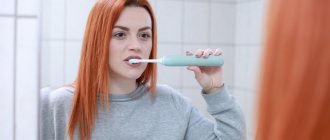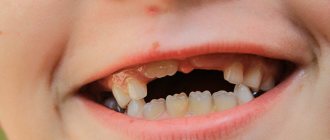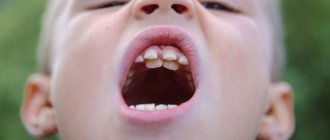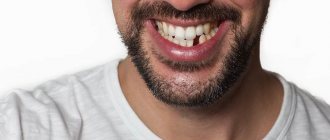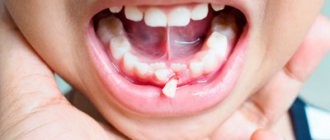Author: Brodsky Sergey Evgenievich Deputy Chief Physician, Candidate of Medical Sciences in the specialties: dentistry and medical microbiology If an adult has a child’s (temporary) tooth, there may be various options for its further existence. What is better, to preserve or remove a baby tooth in an adult patient, can be found in this article.
- Features of children's teeth
- Baby teeth in permanent dentition: reasons
- Removal of baby teeth in adults
- Problems with baby teeth in adults
Echo of childhood
Milk teeth are something from the realm of a carefree and touching childhood, most of us are sure. It is not for nothing that the Scottish writer James Barrie, in the fairy tale about Peter Pan - a boy who did not want to grow up and remained forever young - specifically mentions that “his mouth was full of pearly milk teeth. None have fallen out yet.” Replacing baby teeth with permanent ones is the same step into adulthood as first grade and first grade.
The change of teeth begins at the age of 5–6 and usually ends by the age of 14–16. Moreover, according to the observations of doctors, children are currently replacing their baby teeth with permanent ones at a younger age than several decades ago. But sometimes baby teeth persist into adulthood. People encounter similar cases at 20, 30, and even 50 years old! Why does this happen and what should be done in this case?
Teeth crowding - symptoms and treatment
Dental crowding is a developmental pathology, which is characterized by a lack of jaw space for the correct, from a physiological point of view, arrangement of teeth on the jaws. The main manifestation of the anomaly is the incorrect angle of rotation of certain teeth relative to the rest and/or “piling up” of teeth on top of each other, as well as their eruption outside the dental arch.
In the 1980s, the term “clustered teeth syndrome” (TDS) was introduced to describe the anomaly, which defines crowding of the front teeth, which prevents satisfactory oral hygiene [1].
SRD affects 70% of the world's adult population. The anomaly occupies a leading place in the structure of all dental pathologies. The syndrome can manifest itself both during the development of baby teeth and during the eruption of permanent teeth. In the first case, the prevalence is 34%, and in the second - 68% [2][3].
As a person gets older, the degree of crowding of teeth may increase, as changes occur in periodontal tissues: the ligamentous apparatus of the tooth becomes less stable [4]. According to studies, the older the age group of patients, the higher the percentage of people who need orthodontic treatment [5][6][7]. Thus, we can talk about the pattern of distribution of the anomaly by age and the absence of a pattern of distribution depending on gender.
The main reasons for the development of SRD include:
- Quick replacement of baby teeth with molars (up to 6-7 years). The jaw bones do not have time to develop, so there is not enough space for the teeth. However, there is no data on why some children change teeth earlier. This is an individual feature that is caused by abnormalities in the growth and formation of teeth.
- Bad infantile habits, such as thumb sucking or pacifier sucking. As a result, the risk of malocclusion and abnormal tooth growth increases.
- Congenital malocclusions. Changing the size of the jaw (less often the shape) negatively affects the location of molars, premolars, canines and incisors.
- Unfinished development of the alveolar process and the basal part of the jaw.
- Macrodentia, which implies an excessive increase in the size of one or all teeth.
- Narrowing of dental arches due to soft tissue dysfunction. The causes of dysfunction can be hormonal disorders, previous injuries, metabolic disorders, heredity and predisposition, and malocclusion.
- The appearance of third molars - “wisdom teeth”. This reason is typical for people of mature age, when the dentition is already formed and there is no room for “eights” [8].
- Supernumerary teeth - the presence of additional (extra) teeth.
Factors of SRD include: dysfunction of lip closure, abnormality of the frenulum of the tongue, infantile swallowing, mouth breathing [9]. Prolonged mouth breathing in childhood leads to deformation of the facial skeleton: the lateral parts of the upper jaw come closer together, as a result of which the upper jaw develops incorrectly; the hard palate becomes higher and narrower. As a result, the upper dentition becomes significantly narrower. Similar changes subsequently occur in the lower jaw. All this leads to overcrowding.
Why didn't my baby tooth fall out?
The structure of temporary and permanent teeth has certain differences. Dairy teeth have the same shape as molars, but they are smaller in size, their roots are much shorter, and they grow in the amount of only 20 pieces versus 32 permanent ones, including wisdom teeth. The service life of “children’s” teeth is also short: their roots begin to dissolve (dentists say “resorb”) approximately 2 to 3 years after they are fully formed. The process begins from the area where the crowns of the permanent teeth growing underneath touch them.
However, it happens that the rudiments of molars do not form for some reason. In this case, the roots of the milk teeth most often dissolve under the influence of the rudiments of adjacent permanent teeth. But sometimes this does not happen, and then “children’s” teeth are preserved in adults - doctors call them persistent, from the Latin persistere - to remain, to remain.
The reasons for the absence of permanent tooth buds can be different. Sometimes these are hereditary characteristics, metabolic disorders or disorders of the endocrine glands, trauma and osteomyelitis of the jaws. Chronic and acute inflammatory processes in baby teeth, in particular, periodontitis that is not cured in a timely manner, can also lead to damage and death of the rudiments of permanent teeth.
It also happens that the rudiments of permanent teeth, although they are formed, lie very deep, without touching the roots of milk teeth. This may be caused by insufficient space or misalignment of the permanent tooth. In these cases, milk teeth can remain in an adult.
Delete or leave?
Milk teeth have reduced resistance to the development of caries and other diseases. These teeth are not designed to last. They can interfere with neighboring teeth and visually look different from molars, which disrupts the aesthetics of the smile.
If you find a baby tooth, contact your dentist. The doctor will assess the condition of the tissue and location, degree of destruction and the need for removal. If there are no indications for removal, the dentist will not prescribe this procedure.
Baby teeth are left if:
- the tooth is well preserved and does not interfere with the rest;
- The molar tooth germ is missing, but the roots of the temporary tooth remain intact.
To determine this, the patient needs to undergo an X-ray diagnosis or undergo a 3D tomography. The image will show whether there are prerequisites for the eruption of a permanent tooth, and what is the condition of the milk root.
What to do if an adult’s baby teeth don’t fall out?
Of course, baby teeth often cause problems in adults. Firstly, they are designed to have a short lifespan, and therefore their resistance to caries is much lower than that of permanent teeth. Secondly, baby teeth that do not fall out in time can interfere with the growth of permanent teeth and lead to their incorrect location. However, this does not mean that a baby tooth found in an adult must necessarily be removed. It all depends on each specific case. Most often, doctors recommend keeping well-preserved baby teeth in adults - let them last as long as they can. After all, the permanent ones may never emerge in their place.
In any case, the question of the fate of a baby tooth in an adult is decided only after an x-ray is taken. This will help to find out whether there are rudiments of an unerupted permanent tooth, as well as whether the roots of the baby tooth are being reabsorbed. If there are no rudiments and the roots of the baby tooth have not resolved, while the baby tooth is motionless and looks quite aesthetically pleasing, then it is not worth removing it. The same applies to cases when the permanent tooth, judging by the x-ray, is in such a position that it is impossible for it to erupt even after the removal of the milk tooth.
What to do?
Due to the fact that the lifespan of a baby tooth is much shorter than a molar one, its resistance to caries is much lower, so temporary teeth can cause many problems to their owner. In addition, milk teeth that are not eliminated in time interfere with the development of permanent teeth, stimulating incorrect positioning and the formation of an atypical bite.
However, it is not always necessary to remove a baby tooth when it is discovered. If the germ of a permanent tooth is not observed, that is, a new tooth will not grow, and the milk tooth is in good condition and does not cause discomfort or problems, then dentists recommend preserving it so that the tooth serves its purpose.
The best way to determine the fate of a baby tooth is with an X-ray or CT scan of the jaw. X-ray diagnostics will show whether there are rudiments of a permanent tooth and whether the process of root resorption has begun.
Is it possible to grow a baby tooth on an adult?
If the baby tooth is mobile or does not suit you from an aesthetic point of view, you still need to start with an x-ray examination. If the x-ray reveals that there are no permanent tooth buds, and the roots of the baby tooth have resolved, while the baby tooth has mobility of 3–4 degrees (that is, the tooth is very mobile), then it should be removed and further decide what type Prosthetics are more suitable for you to replace the loss.
If you are not satisfied with the appearance of the tooth, it is necessary, again using an x-ray, to determine the condition of the rudiments of the permanent tooth and the roots of the baby tooth. Further decisions will depend on each specific case, including the age of the patient and the place in the dentition of the baby tooth. If there are no rudiments and the roots of the baby tooth have not resolved, then you can install a veneer on it or carry out a tooth restoration, which will make it invisible in the dentition. And for those who want to completely transform their hair, we can recommend getting lumineers.
If there are rudiments of a permanent tooth, in this case it is worth assessing how much time they need before erupting and making a decision about removing the baby tooth and “pulling out” the permanent one.
Although milk teeth in adults are an anomaly, this is not a reason to necessarily part with them - they can serve you well for many years to come. However, it is possible that this “greetings from childhood” prevents the permanent tooth from growing. So, if you suddenly have a baby tooth, be sure to take an x-ray and consult a specialist.
How to keep your smile?
If there are no molar rudiments in the image and there are indications for removal, the specialists at Family Dentistry will offer to use the prosthetic service.
If the patient is not satisfied with the baby tooth, the doctor can cover it with a veneer or lumineer. It is also possible to perform tooth restoration.
If there are rudiments of a molar tooth, the dentist estimates how long it will take for eruption to occur. For the baby tooth, extraction is prescribed, and the permanent one is helped to erupt faster.
“Baby” teeth in adulthood are not normal. If the tooth is healthy and not causing problems, it can last for many more years. But, natural molars are much better in functionality and aesthetics than baby teeth or dentures restored by a dentist.
Norms and anomalies during shifts
Normally, during the formation of the rudiments of permanent units, temporary elements are subject to displacement. As the child grows, the primordium begins to grow and its crown touches the milk root. At this point the replacement process begins.
As a result of displacement, the root begins to dissolve and dissolve. This continues until the temporary unit has something to hold on to, then it becomes loose under mechanical stress and falls out, making room for the permanent unit to erupt.
Replacement begins at 5-8 years and usually continues until 12-14.
Absence of rudiments of permanent teeth and premature loss of milk units are considered abnormal. If the replacement rudiment has not formed, then the temporary element remains and is called “persistent” (persistere - to remain, lat.).
The root of a temporary tooth sometimes begins to dissolve earlier than expected under the influence of the crown of the adjacent element. In this case, the replacement occurs much later or, in the absence of a rudiment, it may remain in its place for a long time.
What is caries and where does it come from?
Caries is an infection that develops as a result of the activity of pathogenic microorganisms in the mouth. How can pathogenic microorganisms enter a child's mouth? This happens through saliva:
- when taking a temperature test by a parent
- when kissing parents who have pockets of caries in their mouths;
- if you eat food with one spoon;
- if the child suffers from “nasal breathing” and during sleep he breathes through his mouth.
At night, the child’s mouth dries out and there is no saliva, which has protective properties and slows down the development of caries.
If a child drinks compotes and other sweet drinks at night, the risk of developing caries increases due to the presence in the oral cavity of a favorable environment for cariogenic microorganisms.
Milk teeth are similar in structure to permanent teeth, and they also contain a nervous system. If caries affects the nerve, the tooth hurts greatly, pulpitis, periodontitis and other “adult” problems develop in it.
Differences between permanent and temporary units
Temporary and permanent elements of the jaw row are almost identical in shape, but there are some differences:
- dimensions;
- root length;
- chemical composition;
- number in a row;
- life time.
Temporary elements of the jaw rows are designed in size for a growing organism. The jaw of a child or teenager is much smaller than that of an adult.
For a comfortable life, so that the milk units do not put pressure on each other, do not cause pain, inconvenience when chewing food, and do not injure the surrounding tissues, nature prescribes a smaller size.
The shortened length of the root and differences in composition are provided for by the replacement mechanism, for a relatively painless and traumatic passage.
A child grows only 20 milk units, and after the formation of a permanent bite, 32 or 28 elements erupt (not everyone grows four eights or wisdom teeth).
The service life of a temporary unit is reduced due to the difference in composition, their greater susceptibility to various diseases, and lower resistance to caries. That is why it is not recommended to give children a lot of sweets to maintain health.
Stages of formation of permanent dentition and its characteristics.
Read here about possible anomalies that develop with mixed dentition.
At this address https://orto-info.ru/zubocheliustnye-anomalii/okklyuzii/profilaktiki.html we will talk about a kit for the prevention of malocclusions.

